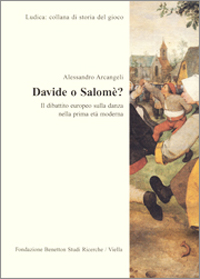
Davide o Salomè?
Il dibattito europeo sulla danza nella prima età moderna
[David or Salome? The European debate about dance in the Early Modern Age]
by Alessandro Arcangeli
Fondazione Benetton Studi Ricerche-Viella
Treviso-Rome 2000
392 pages
18 illustrations black and white
euros 24.79
ISBN 88-8334-006-X
(Ludica, 5)
Should a practising Christian dance? Social customs change in time but the moral issue vis-à-vis dancing has accompanied the history of Christian churches from their earliest times right up to the present day.
A fundamental stage in the debate started with mediaeval theology and preaching and developed between and within the various confessions and national variants of post-Reformation Christianity. The quotations and arguments used in the fierce dispute between the public accusers and the defending advocates of dance tended to cancel each other out. What exactly was the nature of the practice they were so exercised about? Was it like the reverential improvisation of David before the Ark of the Covenant or was it closer to the shamelessly seductive dance of Salome at Herod’s banquet?
The context in which the debate was conducted was that of the Renaissance; dance had reached full aesthetic maturity and also provided a social setting for the acquisition of buone maniere. Doctors recommended it as good physical exercise and curious travellers noted that it was common amongst savages.
Contents
Prefazione, p. 9; Introduzione: danza e processo di civilizzazione, p. 13
I. PRATICHE SOCIALI E RAPPRESENTAZIONI CULTURALI, p. 19
1. La piazza, la sala e la scena, p. 21: 1.1. Le danze, p. 22; 1.2. Maestri e trattati, p. 26; 1.3. La danza come spettacolo, p. 31; 1.4. Danza e società, p. 36
2. L’idea di danza, p. 45: 2.1. Il lessico, p. 45; 2.2. Che cos’è la danza, p. 51; 2.3. Le metafore, p. 58
II. IL GIUDIZIO MORALE: STORIA E GEOGRAFIA DEL DIBATTITO, p. 67
3. Predicatori, teologi e confessori, p. 69: 3.1. Premessa, p. 69; 3.2. Un’officina di immagini, p. 71; 3.3. L’esempio e la predica, p. 78; 3.4. Una quaestio disputata, p. 81; 3.5. Un peccato da confessare, p. 88; 3.6. La somma delle somme, p. 93; 3.7. Dal pulpito, p. 97; 3.8. Festa o rivolta, p. 103
4. Fra umanesimo e Controriforma, p. 107: 4.1. Il discorso umanista: la pazzia del ballo, p. 108; 4.2. Il discorso umanista: le lodi del ballo, p. 111; 4.3. Polemiche postridentine, p. 118; 4.4. Lo spirito santo al balletto, p. 126
5. L’etica riformata, p. 133: 5.1. Dalla Riforma svizzera al calvinismo internazionale, p. 133; 5.2. Le Chiese riformate francesi, p. 138; 5.3. La Riforma inglese, p. 147; 5.4. L’invenzione della tradizione: Luther’s forerunners, p. 162; 5.5. Il dibattito nei Paesi Bassi, p. 164; 5.6. Il calvinismo in Europa centrale, p. 171
6. L’eccezione luterana, p. 175: 6.1. Delectamentum animi, et exercitium corporis, p. 175; 6.2. Una scommessa, p. 182; 6.3. La prospettiva giuridica, p. 185
7. I procedimenti dell’argomentazione, p. 189: 7.1. Auctoritates, p. 190; 7.2. Rationes, p. 204; 7.3. Exempla, p. 210; 7.4. Similitudines, p. 214; 7.5. La civile conversazione, p. 216
8. L’immagine della danza nello specchio della morale, p. 219: 8.1. Un’espressione di letizia, p. 219; 8.2. Un divertimento, p. 224; 8.3. Un’occasione sociale, p. 227; 8.4. Un uso e costume, p. 234; 8.5. Un rito pagano e diabolico, p. 246; 8.6. Un’epidemia, p. 255; 8.7. La dimensione pedagogica, p. 258; 8.8. Le facoltà mimetiche, p. 260
III. ALTRE PROSPETTIVE, p. 263
9. Lo sguardo medico, p. 265: 9.1. Un dono di Dio, p. 265; 9.2. Hygieiná, p. 266; 9.3. Esercizi antichi e moderni, p. 270; 9.4. “C’è una gran differenza fra quelli che l’hanno e quelli che non l’hanno ben imparata”, p. 272; 9.5. Corpo e spirito danzanti, p. 275; 9.6. Capogiri, p. 278; 9.7. “The constitutions of their bodyes”, p. 281; 9.8. Iatrochorea, p. 284; 9.9. “Panum ac Satyrorum saltatio”, p. 286
10. L’osservazione etnografica, p. 289: 10.1. Moeurs comparées, p. 289; 10.2. L’erudizione antiquaria, p. 293; 10.3. Un ballo che conquista, p. 297; 10.4. Un’arte della memoria, p. 300; 10.5. “La pompa del diablo”, p. 305; 10.6. Nel continente nero, p. 313; 10.7. Lo sguardo dell’altro, p. 317
Conclusioni, p. 321; Bibliografia, p. 329; Indice dei passi biblici, p. 373; Indice dei nomi e delle cose notevoli, p. 375; Elenco delle illustrazioni, p. 389
